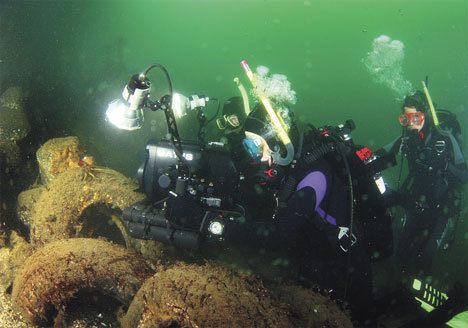The city prides itself on being a picturesque little town by the sea. Russell Sparkman is urging everyone who will listen to look deeper and reap the benefits.
“We have an aquatic treasure,” he said, “a magic kingdom at the bottom of that pier.”
Sparkman, a Langley city councilman and an avid scuba diver, wants to make the Langley Marina a regional destination site that would attract divers and their families from throughout the western United States and Canada, and perhaps the world.
It’s already a favorite site of local Puget Sound divers who come to practice and to see the wonders below, Sparkman said.
For an investment of about $350,000, a section beneath the marina could be turned into an exquisite underwater artificial reef that would generate more than $1 million a year in tourist revenue, he said.
“We can become Puget Sound’s premier diving destination,” Sparkman said. “But if we’re not careful, it’s an opportunity we’ll lose.”
Now’s the time to act, he said, while the Port of South Whidbey, which acquired the marina from the city this year, is planning a $2.2 million redevelopment and expansion of the facility.
“We think it works very well as part of an economic-development approach to the marina,” said Ed Field, port manager, of Sparkman’s proposal. “We’re very supportive of the idea, and it may well work out.
“We’ve set aside an area that might be used for a dive site,” Field added. “But our priority is getting the structures and docks in place.”
What’s already attracting local divers to the marina is its sunken tire reef.
The tires started as a breakwater in the late 1970s, but broke apart in a storm and sank before the decade ended.
Down in the depths, however, the tires have created a haven for a multitude of sea plants and creatures that draw increasing numbers of scuba divers to the area.
But the tires have to go. Even though they’re benign, they’re regarded as unnatural debris, and Puget Sound clean-up regulations require that they be removed as part of the marina development, Sparkman said.
Even if the tires stayed, they would have to be moved, he added. In their current location, they would be directly beneath the proposed new dock, creating a hazard for divers from boat traffic.
But Sparkman is thinking big. He proposes a new artificial reef that would be the envy of other dive locales and attract divers and their wallets from everywhere.
He said local artists could be commissioned to create an underwater theme park, perhaps centered around a sculpture of a gray-whale skeleton. Or maybe one of the state’s decommissioned steel electric ferries might be towed to the site and sunk.
While most divers currently come to Langley for a day or so and spend accordingly, Sparkman said, attracting the regional dive set would increase revenue exponentially.
And at the right time of year, too. Divers in cold-water sites such as Langley prefer the fall and winter months, when the plankton is down and the visibility is clear, Sparkman said.
That means divers would take up the tourist slack in the city after the winding down of summer visitors and the boating season, he said.
While divers come from all walks of life, they are heavily invested in their sport, Sparkman said. The average diver has between $2,300 and $5,000 worth of equipment, and perhaps $3,000 to $12,000 in cameras.
He said that at other destination sites throughout the U.S. and the world, divers and their families typically spend $5,000 per person per week.
A destination dive site in Victoria, British Columbia, which regularly tops the popularity lists in the sport’s publications, brought in $2.3 million in tourist revenue in 1989, he said.
After a specialized artificial reef was built at the site, revenue increased to $9.2 million in 2001 and is up to more than $15 million a year now, Sparkman said.
Closer to home, Edmonds, a regional dive site that spends about $1,000 a year to maintain its underwater artificial reef, attracts 40,000 divers a year and generates $1 million a year in tourist revenue, Sparkman said.
Sparkman, 50, has been diving since he was 15. His first job after high school was as a scuba instructor in the Florida Keys.
His children, Guy, 14 and Maia, 13 have caught the diving bug. Guy, in fact, produced an underwater documentary about the Langley tire reef this year for his eighth-grade project.
Sparkman’s wife, Noriko, doesn’t go underwater. “She’s our dive support team,” Sparkman said. The family tries to go diving about once a month, he added.
Sparkman said that in the state alone, there are 100,000 certified divers, half of which regularly dive in Puget Sound. Another 20,000 come from out of state.
Sparkman said the city already has in place a variety of low-to-high-end amenities — restaurants, stores, lodging — that would cater to the entire dive-crowd spectrum.
“If only 10 percent visited Langley and stayed one night with lodging and meals, that would equal more than $1 million a year,” he said. “It’s all positive.”



